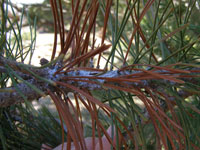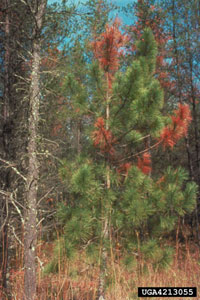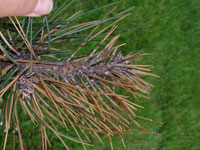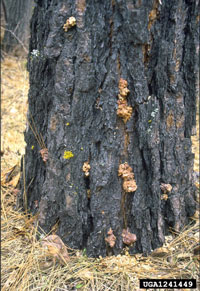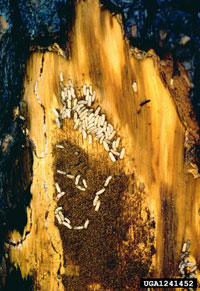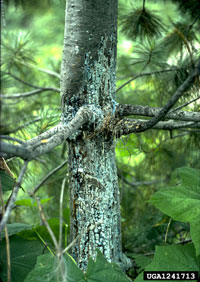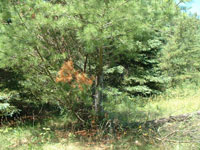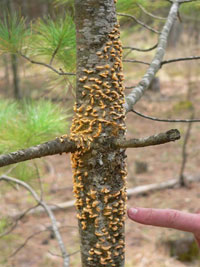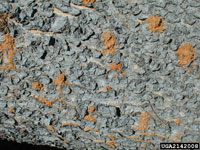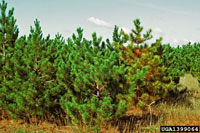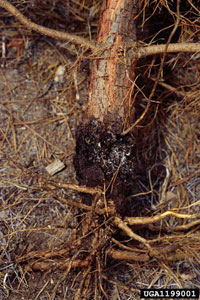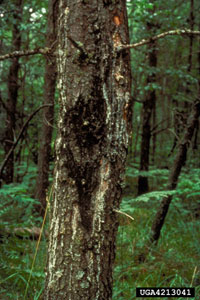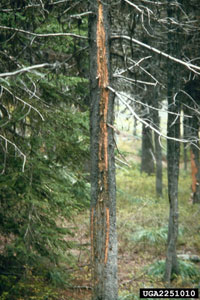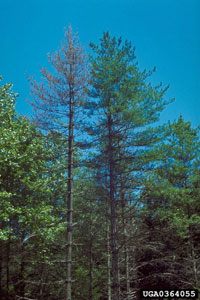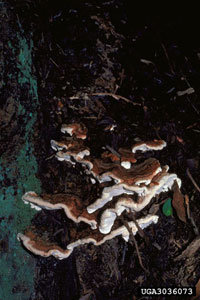Extension > Garden > Diagnose a problem > What's wrong with my plant? > Evergreen Trees and Shrubs > Pine > Resin on trunk or branches
Pine > Trunk/Branches > Resin on trunk or branches
1 of 7
Diplodia shoot blight
Diplodia pinea
- New needles are brown, short and often glued together with resin
- Cankers are resin coated flattened areas on branches
- Needles and branch beyond canker turn brown and dies
- Tiny, black, pimple-like fungal structures on dead needles and pine cones
- Infected shoots and dead branches occur throughout the tree but most commonly in lower canopy
- Cankers and dead needles can appear rapidly after wounding from hail, drought or other stress
- Olive to dark brown streaking in sapwood below cankers
- Common on Austrian, red and Scots pine
- More information on Diplodia shoot blight
2 of 7
Red turpentine beetle
Dendroctonus valens
- Pitch tubes present, i.e. small masses of pitch at entry hole pitch tubes, on lower 3 feet of trunk
- All pine species susceptible but favors stressed trees
- Adults reddish-brown, ¼ - 3/8 of an inch long
3 of 7
White pine blister rust
Cronartium ribicola
- All needles on one or several branches die and turn completely reddish-orange
- Young cankers are elliptical, bark appears swollen and discolored yellowish orange
- Older cankers exude large amounts of white sticky resin and have cracked bark
- In early spring, orange-yellow blisters appear on the bark of cankers that are 2 or more years old
- In summer, yellow-orange sticky liquid droplets form in cankers 3 years or older
- Only white pine and other five needled pines can be infected
- More information on White pine blister rust
4 of 7
Ips bark beetles
Ips spp..
- Adults bore numerous holes less than 1/8 inch diameter in bark which can resemble being shot by a BB gun or shot gun
- Entrance holes often have a reddish-brown, resin-soaked fine sawdust
- Larvae feed under bark
- Needles turn yellow and reddish-brown
- Adults are dark brown to black and range in size from about 1/8 to ¼ of an inch long
- Favors stressed pines of all species
- More information on Ips bark beetles
5 of 7
Pine root collar weevil
Hylobius radicis
- Large amounts of pitch are exuded, darkening the root collar and nearby soil
- Discolored needles, from yellow to reddish-brown on entire tree
- Infested trees often tip due to feeding damage
- Most pine attacked; prefers pine growing on sandy soils with heavy grass competition
- Adults are ¼ inch long, reddish brown to black with whitish to yellowish spots (patches of scale); has conspicuous snout
- Larvae about ⅓ inch long, whitish and grub-like
- More information on Pine root collar weevil
6 of 7
Comandra, Stalactiform or Sweetfern rust
Cronartium comandrae, Cronartium coleosporioides, and Cronartium comptoniae
- When severe, canopy is thin, has poor growth, needles yellow, turn brown and die
- On young stems or branches, infection may appear as a swollen, elliptical area
- Infection develops into a long, flattened, resin soaked canker on the main trunk
- Sweetfern rust cankers frequently occur near the soil level and grow up to 6 ft. long
- Stalactiform rust cankers grow up to 25 ft. long along the main trunk
- Comandra rust cankers occur on the main trunk and rarely grow over 4 ft. long
- Ridges of wound wood may be present along edges of the canker
- Pale yellow blisters of powdery spores break through cracks in bark in spring, sticky orange drops form along canker edges in late summer to fall
- On young stems or branches, infection may appear as a swollen, elliptical area
- Jack and ponderosa pine most severely affected, but many 2-3 needle pines are susceptible
- Differentiation between the 3 species is most accurate with a lab analysis
- More information on Comandra, Stalactiform or Sweetfern rust
7 of 7
Heterobasidion root disease and butt rot
Heterobasidion irregulare (previously known as H. annosum)
- Slow growth, thin canopy, and discolored needles in severely infected trees
- Resin soaked bark at base of tree
- Sapwood of roots and butt discolored brown
- Groups of infected trees commonly found in area where trees have been removed
- Wood decays with a stringy white rot
- Trees eventually die, windthrow common
- Popcorn like white fungal structures that grow into leathery fungal conk, white to reddish brown above, cream colored with multiple pores below
- Fungal conks common on cut stumps but often rare on infected trees
- Infects most pines and other conifers
- Not yet identified in Minnesota; if found, contact Arrest the Pest: 1-888-545-6684 or Arrest.the.Pest@state.mn.us
- More information on Heterobasidion root disease and butt rot



